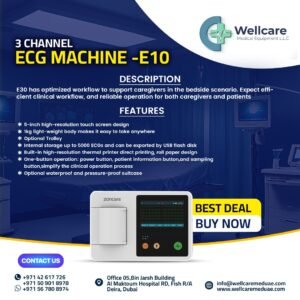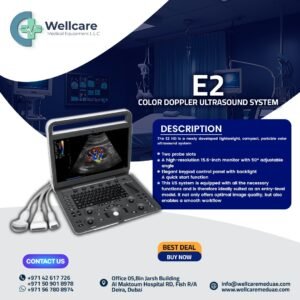AMBULANCE DEALER IN THE UAE: A Spotlight on Well Care Medical Equipment LLC
In the field of emergency medical services, having reliable and fully equipped ambulances is crucial to saving lives and providing timely care. Ambulances are critical to emergency medical care, providing rapid response, life-saving equipment, and skilled personnel to patients in urgent need. They bridge the crucial gap between the site of an emergency and a healthcare facility, ensuring that patients receive immediate care while being safely transported. Equipped to handle various medical emergencies, from cardiac arrest to trauma, ambulances increase survival rates by enabling timely interventions and stabilizing patients en route to hospitals. Their role is vital in strengthening healthcare systems, as they help reduce response times, improve patient outcomes, and support communities in handling emergencies efficiently. As one of the UAE’s leading suppliers of medical equipment and emergency vehicles, Well Care Medical Equipment LLC has earned a reputation for delivering high-quality, purpose-built ambulances tailored to meet the diverse needs of healthcare providers, government organizations, and private companies.
Well Care Medical Equipment LLC understands that different situations and organizations require various types of ambulances and customization options. To meet these needs, the company offers a range of ambulances, from basic patient transport vehicles to fully equipped intensive care units on wheels. Their selection includes:
Basic Life Support (BLS) Ambulances: Designed for non-critical situations, BLS ambulances provide safe patient transport with essential medical equipment and supplies. These vehicles are ideal for transferring patients between facilities or from home to the hospital, ensuring comfort and safety.
Advanced Life Support (ALS) Ambulances: For more serious emergencies, ALS ambulances come equipped with advanced medical equipment, including defibrillators, cardiac monitors, ventilators, and a range of medications. These vehicles are designed to provide life-saving interventions en route to a hospital.
Mobile Intensive Care Units (MICU): MICUs are equipped with ICU-grade equipment, allowing for the transport of critically ill patients who require constant monitoring and advanced care. These ambulances serve as fully functional intensive care units, complete with ventilators, advanced monitoring systems, and specialized medical equipment.
Specialized Vehicles: Well Care Medical Equipment LLC also provides specialized ambulances, including neonatal units and bariatric ambulances, ensuring that patients with unique medical needs are safely and comfortably transported.
Quality and Customization to Suit Every Requirement
Well Care Medical Equipment LLC is known for prioritizing quality and customization. The company sources vehicles from leading global manufacturers, ensuring that each ambulance meets the highest standards of safety and reliability. With an understanding that each client may have unique requirements, Well Care works closely with clients to customize ambulances based on specific needs. This includes selecting equipment configurations, designing interiors, and integrating advanced features for monitoring and communication.
This approach ensures that healthcare providers in the UAE have access to ambulances that align with their operational needs, whether it’s for rapid emergency response, inter-facility transfers, or critical care transport. The ability to customize each vehicle has made Well Care Medical Equipment LLC a go-to partner for both private and public healthcare providers who need versatile, efficient, and reliable ambulance solutions.
High Standards of Safety and Compliance
In the UAE, adhering to international safety and quality standards is essential. Well Care Medical Equipment LLC’s ambulances are built in compliance with global standards, including certifications from relevant medical and automotive regulatory bodies. This focus on safety means that each vehicle is equipped with features designed to protect both patients and medical staff. Features such as anti-lock braking systems (ABS), airbags, GPS navigation, and enhanced suspension systems are just a few of the components that ensure a safe and smooth ride for everyone on board.
Reliable and Timely After-Sales Support
Well Care Medical Equipment LLC distinguishes itself by providing reliable after-sales support to its clients. This includes regular maintenance, repair services, and parts replacement to keep each ambulance in peak operating condition. Their dedicated after-sales team is equipped to handle routine servicing as well as urgent repairs, minimizing downtime and ensuring that ambulances remain available for emergency response whenever needed. By offering ongoing support, Well Care Medical Equipment LLC fosters strong relationships with clients and ensures that they can depend on their ambulances long after the initial purchase.
Cutting-Edge Technology Integration
As technology evolves, Well Care Medical Equipment LLC stays at the forefront of innovation in emergency medical response. Many of the ambulances they offer come equipped with advanced communication and telemedicine systems, allowing for real-time data transmission between the ambulance and the receiving hospital. This capability enables hospital staff to prepare for the incoming patient based on real-time data, which can be critical in improving patient outcomes.
Telemedicine integration allows paramedics to consult with physicians and receive guidance on treatment protocols, further enhancing the level of care that patients receive en route. Additionally, Well Care’s ambulances may feature digital monitoring systems that track and record vital signs, oxygen levels, and other crucial information, which can be reviewed later by healthcare professionals.
Supporting a Strong Healthcare Infrastructure
In the UAE, where healthcare is a top priority, Well Care Medical Equipment LLC plays a crucial role in strengthening the country’s emergency response system. By providing state-of-the-art ambulances and ensuring they are well-maintained and equipped, Well Care Medical Equipment LLC directly contributes to the UAE’s goals of providing high-quality healthcare and improving patient outcomes. Their ambulances are integral to the country’s ability to respond quickly and effectively to medical emergencies, be it on the highways, in densely populated urban areas, or in remote locations.
Well Care Medical Equipment LLC stands out as a trusted and reliable ambulance dealer in the UAE, providing high-quality emergency vehicles that meet the demands of the country’s healthcare system. Their dedication to safety, innovation, and customization ensures that each ambulance is a valuable asset in delivering lifesaving care to patients across the UAE. By choosing Well Care Medical Equipment LLC, healthcare providers and emergency response organizations gain a dependable partner that not only delivers top-notch ambulances but also supports them with the expertise and commitment necessary for sustained, high-quality emergency medical services.




